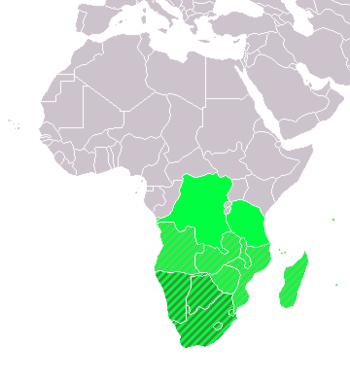
Southern Africa
Did you know...
SOS Children offer a complete download of this selection for schools for use on schools intranets. A quick link for child sponsorship is http://www.sponsor-a-child.org.uk/
Southern Africa is the southernmost region of the African continent, variably defined by geography or geopolitics. Within the region are numerous territories – including the Republic of South Africa, a successor country to the Union of South Africa.
Definitions and usage
In the UN scheme of geographic regions, five countries constitute Southern Africa:
The region is often reckoned to include other territories:
- Angola – also included in Central Africa
- Mozambique and Madagascar – also included in Eastern Africa
- Malawi, Zambia, and Zimbabwe – sometimes included in Southern Africa and formerly of the Central African Federation
- Comoros, Mauritius, Seychelles, Mayotte, and Réunion – small island territories in the Indian Ocean and near East Africa mainland.
The Democratic Republic of the Congo and Tanzania, though more commonly reckoned in Central and Eastern Africa respectively, are occasionally included in Southern Africa. Apropos, the Southern African Development Community (SADC) was established in 1980 to facilitate co-operation in the region, which includes all of the above except Comoros (totalling 15 members).
The Southern African Customs Union (SACU), created in 1969, comprises the five countries in the UN subregion of Southern Africa.
The term Southern Africa was also used to refer to South Africa and the "independent" Bantustans that were re-incorporated into South Africa following the end of Apartheid in 1994.
Another geographic delineation for the region is the portion of Africa south of the Cunene and Zambezi rivers – that is, South Africa, Lesotho, Swaziland, Namibia, Botswana, Zimbabwe and the southern half of Mozambique. This definition is most commonly used in South Africa.
Geography
The terrain of Southern Africa is varied, ranging from forest and grasslands to deserts. The region has both low-lying coastal areas, and mountains.
In terms of natural resources, the region has the world's largest resources of platinum and the platinum group elements, chromium, vanadium, and cobalt, as well as uranium, gold, titanium, iron and diamonds.
Economy
The region is distinct from the rest of Africa, with some of its main exports including platinum, diamonds, gold, and uranium, but it is similar in that it shares some of the problems of the rest of the continent. While colonialism has left its mark on the development over the course of history, today poverty, corruption, and HIV/AIDS are some of the biggest factors impeding economic growth. The pursuit of economic and political stability is an important part of the region's goals, as demonstrated by the SADC.
Environmental factors
The region has a wide diversity of ecoregions including grassland, bushveld, karoo, savanna and riparian zones. Even though considerable disturbance has occurred in some regions from habitat loss due to human overpopulation, and there remain significant numbers of various wildlife species, including White Rhino, lion, leopard, impala, kudu, blue Wildebeest, Vervet monkey and elephant.
Culture and peoples
Southern Africa is home to many cultures and peoples. It was once populated by San, Namaqua and Pygmies in widely-dispersed concentrations. Due to the Bantu expansion which edged the previous peoples to the more remote areas of the region, the majority of ethnic groups in this region, including the Zulu, Xhosa, Swazi, Ndebele, Tswana, Sotho, and Shona people, BaLunda, Mbundu, Kikuyu and Luo, speak languages which share common Bantu language traits. The process of colonization and settling resulted in a significant population of European ( Afrikaners, Anglo-Africans, Portuguese Africans, etc.) and Indian descent ( Cape Malays, Koreans, Tamils, etc.) in many southern African countries.


